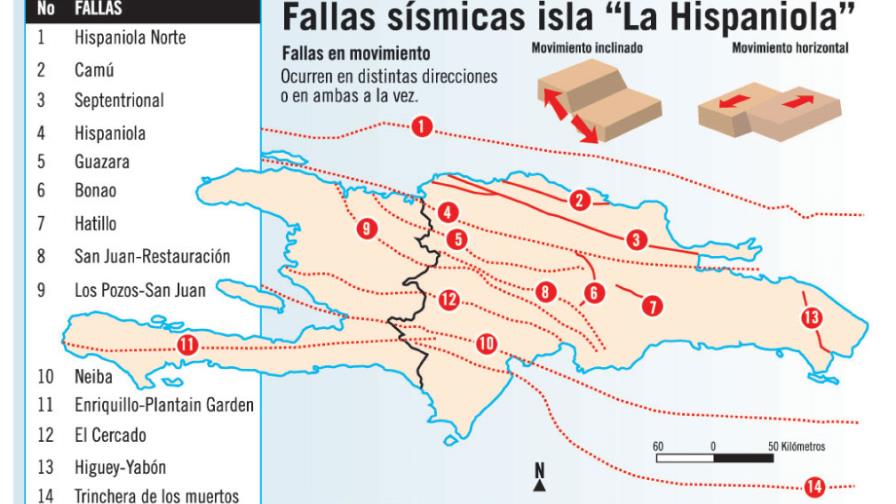Cibao prepares for eventual 7.5 quake
Santo Domingo should prepare as well

SANTO DOMINGO. Faced with the forecast of a 7.5 degree earthquake (50% stronger than the one in Haiti) that would affect Santiago and the Cibao and that 70% of the buildings would not stand up, the authorities have begun a campaign that will include simulations, distribution of educations materials, and signage for buildings on buildings in the cities that have gone up along the active Septentrional Fault.
"We have already placed signs in several buildings in this city (Santiago), including public and private schools that indicate evacuation routes, meeting places and the safest locations", said the national sub-director for Civil Defense, Francisco Arias. Among those with signage are the Padre Emiliano Tardiff School and the Polytechnic School Altagracia Iglesia de Lora.
But, this is not sufficient. The geologist Orlando Franco suggested that the government test the public buildings in the Cibao, with priority for schools and hospitals, in order to retrofit them to resist earthquakes.
The community of Santiago requested the activation of the campaign after the 7.0 degree earthquake in Haiti that left more than 150,000 dead, caused a tsunami alert and was felt as a 5/.1 tremor in the Dominican Republic.
The president of the Dominican College of Engineers, Architects and Surveyors (CODIA), Silvio Duran, emphasized the fact that the majority of old buildings that house large groups of people, like hospitals and schools, will be the first to collapse, since most of them are more than 50 years old.
During the conference on the earthquake in Haiti, the engineer, Leonardo Reyes Madera went even further: "Some 1500 public buildings all over the country run the risk of disappearing in the case of a certain size earthquake similar to what happened in Haiti. Within these structures....are public schools, hospitals and public housing without proper design, and other, especially those of less than four stories for which the Ministry of Public Works does not require seismic analysis."
Geologist and civil engineer Orlando Franco also placed the poorer barrios on alert since construction there is generally without any supervision or professional guidance.
Quake in Haiti should have been in DR
Last week the American geophysicist Eric Calais, who has done research on the Caribbean faults, said in the New York Times: If I would have had to make a bet, I would have bet that the first earthquake would have happened in the north of the Dominican Republic, not in Haiti."
Geologist Orlando Franco is in agreement. "We have always said this, because in the North there are two fault lines, tow areas where there can be a break. The surprise with the event in Haiti is that the seismic activity has moved to the South, but it is still a latent danger in the North."
The Center of Emergency Operations (COE) includes in its National Contingency Plan for Earthquakes, an alert for the North of the country due to the threat that the Septentrional Fault represents. The 8.1 quake in 1946 that destroyed Matancitas, Nagua was caused by a "seaquake" deep in the Hispaniola Trench to the east of Nagua.
Fault lines in the DR
Science cannot predict the day and time of a telluric movement. The island of La Hispaniola, shared by Haiti and the Dominican Republic, has dozens of small faults "over shown" by 11 of greater notoriety: Camu, the North of Hispaniola and the Hispaniola, Septentrional, Guazara, Bonao, Hatillo, San Jose de Ocoa-Restauración, Los Pozos-San Juan, Enriquillo-Plantain Garden, El Cercado San Juan, Trinchera de los Muertos and North of Bahoruco. It was the Enriquillo-Plantain Garden fault that caused the earthquake that devastated Port-au-Prince, Carrefour, Leogane, Jacmel and other towns in Haiti.
The director of the Seismological Institute, engineers and geologists insist on the need to contruct buildings that are strong and warn of the lack of respect for the construction norms. One example of this is that as a result of the earthquake in Haiti, 111 schools in the Dominican Republic reported damages.
The investigators say that there is a need for more study on the Septentrional and Enriquillo Faults as well as others in the Caribe. They also suggest that governments prepare for the inevitable.
Santo Domingo is vulnerable
As of last week, there have been 89 after-shocks from the earthquake in Haiti, with one 6.1 (later reduced to 5.8). The National District and the province of Santo Domingo are not located on a fault line per se, but there are so many nearby as to make them vulnerable to any movement. An example of this is that the investigators expect that the quake should have been in other zones of Haiti and not in Port-au-Prince where the earthquake was felt together with the aftershocks. There are earthquakes every day, mostly imperceptible. One of the most recent occurred last Thursday in the Mona Passage and was 3.5 in its intensity.
"We have already placed signs in several buildings in this city (Santiago), including public and private schools that indicate evacuation routes, meeting places and the safest locations", said the national sub-director for Civil Defense, Francisco Arias. Among those with signage are the Padre Emiliano Tardiff School and the Polytechnic School Altagracia Iglesia de Lora.
But, this is not sufficient. The geologist Orlando Franco suggested that the government test the public buildings in the Cibao, with priority for schools and hospitals, in order to retrofit them to resist earthquakes.
The community of Santiago requested the activation of the campaign after the 7.0 degree earthquake in Haiti that left more than 150,000 dead, caused a tsunami alert and was felt as a 5/.1 tremor in the Dominican Republic.
The president of the Dominican College of Engineers, Architects and Surveyors (CODIA), Silvio Duran, emphasized the fact that the majority of old buildings that house large groups of people, like hospitals and schools, will be the first to collapse, since most of them are more than 50 years old.
During the conference on the earthquake in Haiti, the engineer, Leonardo Reyes Madera went even further: "Some 1500 public buildings all over the country run the risk of disappearing in the case of a certain size earthquake similar to what happened in Haiti. Within these structures....are public schools, hospitals and public housing without proper design, and other, especially those of less than four stories for which the Ministry of Public Works does not require seismic analysis."
Geologist and civil engineer Orlando Franco also placed the poorer barrios on alert since construction there is generally without any supervision or professional guidance.
Quake in Haiti should have been in DR
Last week the American geophysicist Eric Calais, who has done research on the Caribbean faults, said in the New York Times: If I would have had to make a bet, I would have bet that the first earthquake would have happened in the north of the Dominican Republic, not in Haiti."
Geologist Orlando Franco is in agreement. "We have always said this, because in the North there are two fault lines, tow areas where there can be a break. The surprise with the event in Haiti is that the seismic activity has moved to the South, but it is still a latent danger in the North."
The Center of Emergency Operations (COE) includes in its National Contingency Plan for Earthquakes, an alert for the North of the country due to the threat that the Septentrional Fault represents. The 8.1 quake in 1946 that destroyed Matancitas, Nagua was caused by a "seaquake" deep in the Hispaniola Trench to the east of Nagua.
Fault lines in the DR
Science cannot predict the day and time of a telluric movement. The island of La Hispaniola, shared by Haiti and the Dominican Republic, has dozens of small faults "over shown" by 11 of greater notoriety: Camu, the North of Hispaniola and the Hispaniola, Septentrional, Guazara, Bonao, Hatillo, San Jose de Ocoa-Restauración, Los Pozos-San Juan, Enriquillo-Plantain Garden, El Cercado San Juan, Trinchera de los Muertos and North of Bahoruco. It was the Enriquillo-Plantain Garden fault that caused the earthquake that devastated Port-au-Prince, Carrefour, Leogane, Jacmel and other towns in Haiti.
The director of the Seismological Institute, engineers and geologists insist on the need to contruct buildings that are strong and warn of the lack of respect for the construction norms. One example of this is that as a result of the earthquake in Haiti, 111 schools in the Dominican Republic reported damages.
The investigators say that there is a need for more study on the Septentrional and Enriquillo Faults as well as others in the Caribe. They also suggest that governments prepare for the inevitable.
Santo Domingo is vulnerable
As of last week, there have been 89 after-shocks from the earthquake in Haiti, with one 6.1 (later reduced to 5.8). The National District and the province of Santo Domingo are not located on a fault line per se, but there are so many nearby as to make them vulnerable to any movement. An example of this is that the investigators expect that the quake should have been in other zones of Haiti and not in Port-au-Prince where the earthquake was felt together with the aftershocks. There are earthquakes every day, mostly imperceptible. One of the most recent occurred last Thursday in the Mona Passage and was 3.5 in its intensity.

 Diario Libre
Diario Libre
 Diario Libre
Diario Libre